There are four species of venomous snakes in Nebraska. Among these are three species of rattlesnakes, which are known for their distinct rattling warning. The state is also home to the Eastern Copperhead.
Nebraska has an average of 46 snake bites reported annually. Understanding these snakes and their habitats is crucial for outdoor safety.
We’ll dive into in-depth profiles of these venomous snakes, focusing on how to identify them and where they are commonly found in Nebraska. We will also provide safety tips for avoiding dangerous encounters.
If you enjoy being outdoors, this comprehensive resource on Nebraska’s venomous snakes will equip you with the knowledge to stay safe and informed.
Pit Vipers: The Venomous Masters of Infrared Detection
Rattlesnakes, Copperheads, and Cottonmouths are among the most well-known members of the venomous Crotalinae subfamily, also referred to as pit vipers. These snakes are equipped with unique adaptations that make them exceptional hunters.
What Makes Pit Vipers Unique?
- Infrared-Sensing Pits:
A defining feature of pit vipers is the deep facial pit between their nostril and the eye on each side of their head. These specialized infrared-detecting organs allow pit vipers to sense heat emitted by prey. This adaptation enables them to:- Detect body heat from up to 1 meter away.
- Strike prey with pinpoint accuracy, even in complete darkness.
- Triangular Heads and Vertical Pupils:
- Head Shape: Pit vipers are recognized by their distinct triangular-shaped heads, which house their venom glands.
- Eyes: They have vertical elliptical-shaped pupils.
- Venomous Fangs:
Pit vipers have hollow fangs connected to venom glands. These fangs fold back against the roof of their mouth when not in use.
Ecological Importance
Pit vipers are crucial in maintaining ecosystem balance by controlling rodent populations. Despite their fearsome reputation, these snakes are vital to the health of many habitats.

Eastern Copperhead (Agkistrodon contortrix)
The Eastern Copperhead is a pit viper native to the eastern and midwestern United States.
What Do Eastern Copperheads Look Like?
| Coloration | *Reddish-tan to grayish-tan bodies. *Overlaid with dark brown, hourglass-shaped markings. *Heads are dark coppery brown, giving them the name “Copperhead.” |
| Body Shape | *Stout and heavy-bodied snakes. *As with all pitvipers, their heads are triangular and appear oversized in relation to their necks. |
| Size | *Adults range from 20 to 37 inches (50 to 95 cm) in length. |
| Conservation Status | *Common venomous snake in southeastern Nebraska. |
Taxonomy of Nebraska’s Eastern Copperhead Snakes
Copperhead snakes are now recognized as a single species: the Eastern Copperhead (Agkistrodon contortrix).
In the past, these snakes were classified into different subspecies, including the Northern Copperhead, Southern Copperhead, and Osage Copperhead. However, recent DNA studies revealed minimal genetic differences between them. As a result, these subspecies were combined into a single taxonomic group under the Eastern Copperhead name.
Where Do Eastern Copperheads Live in Nebraska?
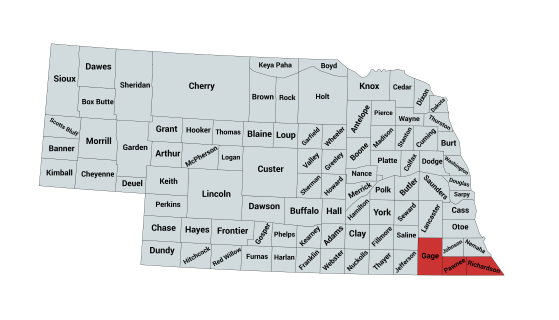
You will find the Eastern Copperhead in the southeastern corner of Nebraska. Their range takes in Richardson, Pawnee, and Gage counties. They inhabit wooded areas such as river bottoms.
Eastern Copperhead Behavior
Copperheads have excellent camouflage coloration. It helps them blend in with leaf litter and other ground debris. Furthermore, they use camouflage as their number one defense mechanism. In other words, these snakes choose to lie perfectly still rather than flee most of the time.
For defensive behavior, they occasionally mimic the tail vibration of a rattlesnake. But, in most cases, they choose to lie perfectly still.
Most copperhead bites on humans occur when the person steps on or near the snake.
What Do Eastern Copperheads Eat?
Copperheads prey on a variety of species. Their menu includes small rodents, amphibians, small birds, snakes, lizards, and large insects.
How Dangerous are Copperheads?
A Copperhead can bite and inject venom when they are newly born. Like most pit vipers, they have hemotoxic venom.
Most copperhead bites are not life-threatening. On the other hand, any bite from this snake is a medical emergency and should be treated as such. If a copperhead bite victim gets medical help fast, they have a better chance of a positive outcome.
Copperhead bites can cause intense pain, shock, and swelling. Their bites also have the potential to cause blood in urine, tissue damage, and kidney failure.
An interesting study has found that Copperhead venom contains a protein called contortrostatin. Contortrostatin has been found to stop the growth of cancer cells in mice.
Rattlesnakes of Nebraska
Nebraska is home to the following three rattlesnakes:
- the Prairie Rattlesnake,
- the Timber Rattlesnake
- the Western Massasauga Rattlesnake.
Rattlesnakes are pit vipers. See the description of pit vipers above.
What Nebraska’s rattlesnakes have in common with most other rattlesnake species is their rattle.
- Most rattlesnakes have a rattle at their tail’s end, comprised of hollow, loosely interlocked keratinous scales.
- Normally, a rattlesnake adds a new segment to its rattle each time it sheds its skin.
- An agitated rattlesnake rapidly vibrates its tail, causing the segments of its rattle to vibrate together, creating a buzzing or rattling sound.
- Not all Nebraska’s rattlesnakes rattle before they strike. Sometimes, they lose their rattles due to injury, and sometimes, they choose not to rattle.
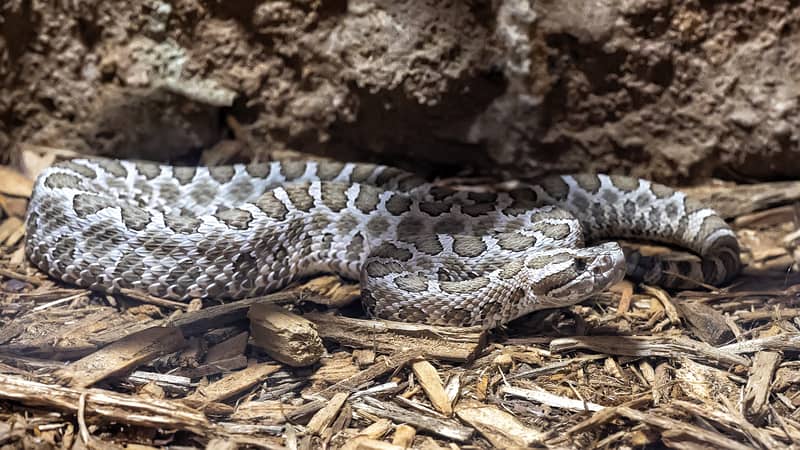
Western Massasauga Rattlesnakes (Sistrurus tergeminus)
What Do Western Massasauga Rattlesnakes Look Like?
| Size | *Adults range from 14 to 36 inches (36 cm to 91cm) long. |
| Coloration | *Their base color is light gray. *Younger snakes are paler than adults. |
| Dorsal Spots | *A row of large, rounded, dark brown spots run down their spine. *They have three smaller rows of spots down each side. *In some cases, the larger dorsal spots connect with the side spots, forming a large solid blotch. |
| Face | *They have a dark stripe on each side of their face and across their eye. |
| Conservation Status | *Threatened species in Nebraska. |
Where Do Western Massasaugas Live in Nebraska?
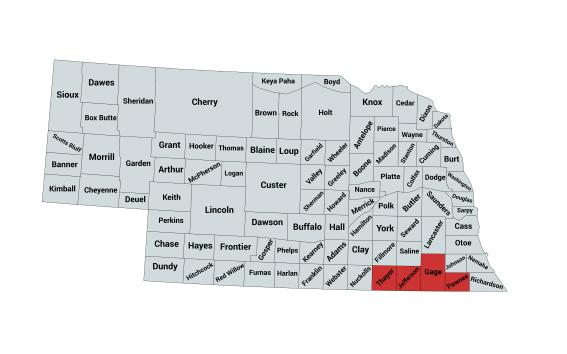
Western Massasaugas live in the tall grass prairies of southeastern Nebraska. Their range takes in Jefferson, Gage, Thayer, and Pawnee counties.
Western Massasauga Behavior
In Nebraska, Western Massasaugas are generally diurnal or active during the day. However, they may be most active at dawn or dusk in the summer. This helps them avoid overheating.
Massasaugas are timid snakes that prefer to rely on their camouflage for protection. They may lie perfectly still when you approach rather than sounding a warning rattle. When they do rattle, the sound is high-pitched. It brings to mind the buzzing of an insect.
If you approach one of these snakes too closely, they may try to escape to thicker cover. They will bite you as a last resort. Be careful about where you place your hands and feet when you’re in these snakes ‘habitat. Several people receive massasauga bites each year.
Like other reptiles, Western Massasauga rattlesnakes brumate in the winter. Brumation is a reptile’s version of hibernation. In southeastern Nebraska, Western Massasaugas brumate exclusively in crayfish burrows. Sometimes, they spend the winter alongside the crayfish that dug the burrow.
What Do Western Massasaugas Eat?
Adult Western Massasaugas mostly eat small mammals such as voles, mice, and shrews. They also might consume small snakes, lizards, birds, and frogs. Young massasaugas eat small snakes and tiny shrews.
How Dangerous Are Western Massasauga Rattlesnakes?
The venom of the Massasauga rattlesnake is cytotoxic. Cytotoxic venom destroys body tissue. Moreover, digestive enzymes in cytotoxic venom disrupt blood flow and prevent clotting. Massasauga bites to humans are rare. However, they do occur.
There are two documented deaths in Ontario from Eastern Massasauga envenomation. In each case, the victim did not receive antivenom in time.
Scorpions in Nebraska – Krebs Creek
8 of the Edible Wild Berries Found in Nebraska – Krebs Creek
Are There Elk in Nebraska? – Krebs Creek
Wild Cats in Nebraska – Krebs Creek
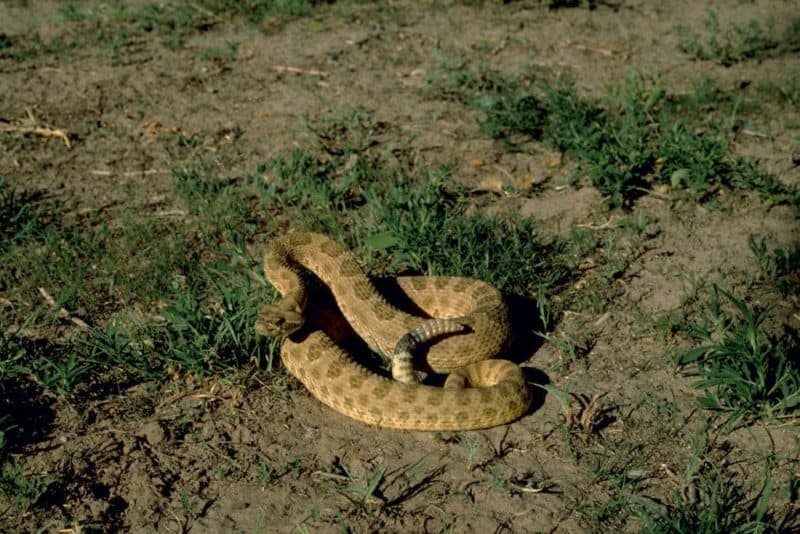
Prairie Rattlesnake (Crotalus viridis)
What Do Prairie Rattlesnakes Look Like?
| Size | *Adults typically measure about 3.3 feet (100 cm) in length. *The longest recorded specimen was just under 5 feet (151.5 cm) long. |
| Coloration | *Their base color varies and can be tan, olive green, or brown. |
| Dorsal Spots | *Brown blotches with darker borders are present on their bodies. |
| Head | *They have a triangular-shaped head with pit sensory organs on either side. *A light stripe runs diagonally from the back of each eye to the jaw. *Another stripe extends diagonally from below the eye to the corner of the mouth |
| Behavior | *Primarily ground-dwelling but occasionally climbs shrubs, bushes, or trees. |
| Conservation Status | *Common within their Nebraska range. |
Where Do Prairie Rattlesnakes Live in Nebraska?

Prairie Rattlesnakes are the most common venomous snake in Nebraska. Their range takes in the western half of the state. They prefer short and mixed grass prairies. They will be out on the open prairies. Also, look for them in areas with rocky outcrops where they can sun themselves.
Prairie Rattlesnake Behavior
Prairie rattlesnakes are mostly ground snakes. But they occasionally climb into shrubs, bushes, or trees.
Prairie Rattlesnakes brumate in communal dens. But their hunting grounds extend seven miles from their dens in the summertime. In the warmer months, prairie rattlers might shelter in old mammal burrows. But in the fall, they will return to their communal dens.
During mating season, male prairie rattlers perform combat rituals. In these, they intertwine and attempt to knock each other to the ground. They do this to compete for the right to breed.
Female Prairie Rattlesnakes can give birth to anywhere from 4 to 25 young in late summer or early fall. The timing varies depending on environmental conditions and the availability of food. Their young are born with venom, which can be harmful if it bites you.
What Do Prairie Rattlesnakes Eat?
The Prairie Rattlesnake has a wide variety of prey because of its extensive range. They prefer small mammals. These include ground squirrels, mice, rabbits, prairie dogs, and rats. They will also dine on ground-nesting birds, amphibians, reptiles, and other snakes.
How Dangerous Are Prairie Rattlesnakes?
Prairie rattlesnake venom is a mix of hemotoxins and myotoxins. Furthermore, according to some literature, it also has neurotoxins.
Prairie rattlesnake bites can have profound effects. The venom can cause severe pain. It may also induce shock, making the victim feel weak and disoriented. Swelling, blistering, and inflammation can occur at the bite site. Their venom can also damage red blood cells and impair blood clotting. In severe cases, the bite may result in severe tissue damage. There is also a risk of harm to internal organs.

Timber Rattlesnake (Crotalus horridus)
Timber Rattler and Canebrake Rattlesnake are both common names for the Timber Rattlesnake. Generally, in higher-elevation habitats, they are called Timber Rattlesnakes. On the coastal plain, though, they’re called Canebrake Rattlesnakes.
What Do Timber Rattlesnakes Look Like?
| Size | *Average length: 36 to 60 inches (0.91 to 1.52 m). *Rare cases reported: Up to 7 feet (2.13 m). |
| Coloration | *General base color: Yellowish-brown to grey-brown. *Chevron pattern: Dark brown to black chevrons on their back and sides against a lighter base color. *Back stripe: Rusty to reddish stripe running down their back. *Tail color: Dark brown or black. |
| Melanistic Variation | *Some timber rattlesnakes exhibit a dark, melanistic color morph. *These snakes can appear almost entirely black. *The tail is darker than the rest of the body in this morph. |
| Behaviors | *These snakes are excellent climbers. In fact, timber rattlers have been found in trees at heights of more than 80 feet. *The experts have proven that timber rattlesnakes help control Lyme disease. This is because as they consume rodents, they’re also consuming ticks. A timber rattler will consume 2,500 to 4,500 ticks per year, depending on the location. |
| Conservation Status | *State threatened species |
Where Do Timber Rattlesnakes Live In Nebraska?
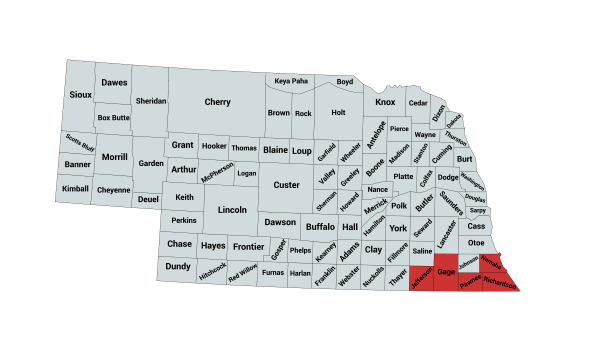
You will find the Timber Rattlesnake in the extreme southeastern corner of Nebraska. Their range includes Nemaha, Richardson, Pawnee, Gage, and Jefferson counties.
The Timber Rattlesnake lives in a variety of habitats. These include deciduous forests, coniferous forests, swamps, agricultural areas, and river flood plains.
What Do Timber Rattlesnakes Eat?
Timber rattlers prey on small mammals such as mice, rats, squirrels, chipmunks, and bats. They also eat small birds, other reptiles, and amphibians.
How Dangerous Are Timber Rattlesnakes?
Timber Rattlesnakes are among the most dangerous in the United States. This is due to their long fangs and high venom yield. 1% to 10% of untreated Timber Rattlesnake bites result in a fatality.
Fortunately, 40% to 60% of the time, they produce dry bites. In other words, although their fangs penetrate the body, they do not inject any venom.
These snakes produce hemotoxic venom. Timber Rattlesnake bites sometimes cause serious complications. These include shock, seizures, coma, internal bleeding, and deep tissue damage.
Nebraska’s Venomous Snakes in Winter: Insights into Brumation
During winter, Nebraska’s snakes, like all reptiles, enter a dormant state called brumation—a hibernation-like period. Because snakes are ectothermic (cold-blooded) and cannot regulate their body temperature internally, they slow their metabolism and become inactive during the colder months.
Brumation Habits
- Solo vs. Communal Brumation: Some snakes brumate alone, while others gather in communal dens. For example, Eastern Copperheads and Timber Rattlesnakes often share dens, which may house up to 60 snakes.
- Mixed-Species Dens: Interestingly, these dens can include non-venomous species. It’s not uncommon to find Black Rat Snakes sheltering alongside venomous snakes.
Regional Variations
- Snakes may only seek shelter in warmer areas on the coldest winter days. They might not enter full brumation due to milder conditions.
Where Snakes Spend Winter
Snakes seek out protected spots to brumate, such as:
- Rock crevices
- Hollow logs
- Fissures on rocky hillsides
- They often choose south-facing slopes because these areas receive more sunlight, providing additional warmth during winter.
This natural adaptation allows Nebraska’s venomous snakes to survive the winter and re-emerge when temperatures rise.
Avoiding Snake Bite
Snakes, including venomous ones, commonly rely on their camouflage to avoid potential threats. They often remain perfectly still to avoid detection. If you’re walking in the woods and unknowingly get too close, a snake might not move, hoping you’ll pass by. This is particularly true of copperheads. Many bites happen when someone accidentally steps on or close to the snake. To stay safe in snake habitats, always watch where you step and where you place your hands.
Another common cause of snake bite is attempts to capture or kill a snake. Remember, venomous snakes can strike instantly, delivering a potentially life-threatening bite. The safest approach is to keep a safe distance and leave them alone.
Dressing for Snake Country
- High-top leather boots and long pants are both wise ideas.
- Also, wear loose-fitting denim. If there’s a gap before the snake’s fangs touch your skin, your chances of being envenomated are lower.
- In the absence of high-top leather boots, some people wear snake gaiters.
Symptoms of Venomous Snake Bites
Some of the symptoms you may experience when a venomous snake bites you include:
- Discoloration in the area of the bite.
- Swelling in the area of the bite.
- Loss of muscle coordination.
- Tingling sensation in the area of the bite.
- Feeling nauseous.
- Having a faster heart rate or rapid pulse.
- Difficulty breathing
What Should You Do if You Are Bitten?
If you or someone you are with has suffered a venomous snakebite, time is of the essence. Because the sooner a victim receives antivenom, the less chance the venom in their body has to cause harm. In other words, it is important to seek immediate medical treatment.
Do not attempt to kill the snake for identification purposes. This gives the snake a chance to bite you again. Also, consider that severed snakeheads can still bite and envenomate and often do. If you have a cell phone, picture the offending reptile. Otherwise, get started on your way to the nearest hospital.
First Aid for Snake Bite Victims
- Remain calm and limit your movements. Do not run. If you must hike back to a vehicle, do it calmly and deliberately. Put as little stress on your heart as possible.
- Keep the area of the snake bite below the heart level and never above the heart level. Keeping the bite below the heart level will reduce the venom’s flow. However, holding the bite above your heart level will increase the venom’s flow.
- Remove all constricting items such as bracelets, watches, or rings before swelling occurs.
- Remember that using a cold compress on a venomous snake bite is not advisable. The cold may cause the local blood vessels to constrict and spread the venom faster.
- You can wash the affected area like any other wound with soap and water.
- You may cover the bite area with a moist dressing to reduce the swelling.
- Get medical attention as soon as possible. Call the emergency room to tell them a venomous snake has bitten you so they can have antivenom ready to give you when you arrive.
- A person whom a venomous snake has bitten may go into shock. If this happens, lay them flat and cover them with a blanket.
Conclusion
The four species of venomous snakes in Nebraska—the Eastern Copperhead, Prairie Rattlesnake, Western Massasauga, and Timber Rattlesnake—are fascinating creatures that play a vital role in the ecosystem. While these snakes can be dangerous, learning about their behaviors, habitats, and unique adaptations will empower people to coexist safely.
You can significantly reduce your snake bite risk by staying vigilant, wearing appropriate clothing, and knowing how to respond to snake encounters. Remember, these snakes prefer to avoid humans and will only strike when threatened. With proper awareness and respect for their presence, you can enjoy Nebraska’s great outdoors while staying safer.
If bitten by a venomous snake, remain calm, limit movement, and seek medical attention immediately. This will increase your chances of a positive outcome. Also, avoid attempting to capture or kill the snake, as this increases the risk of further bites. Reference the first aid tips above.
For more detailed information on wildlife in Nebraska, explore our other articles. Knowledge is your best defense when it comes to enjoying nature responsibly!
Recent Posts
The only venomous snakes in Washington State are Northern Pacific Rattlesnakes. The Northern Pacific Rattlesnake (Crotalus oreganus oreganus) is a sub-species of the Western Rattlesnake. Anyone...
Skunks are not classified as true hibernators. But they go into a state of torpor when the weather gets cold. Skunks are light sleep hibernators, along with opossums, bears, and raccoons. ...
